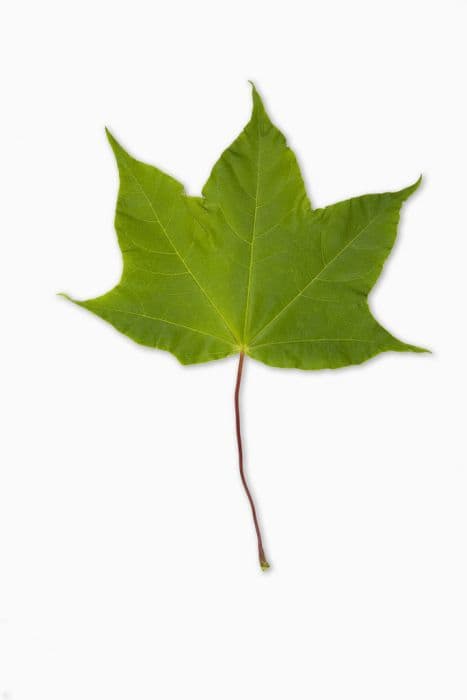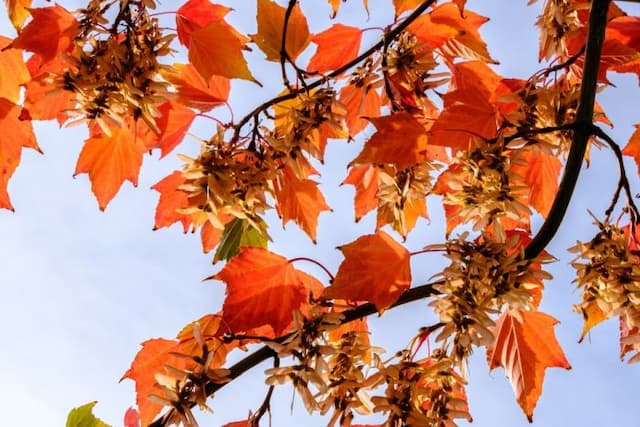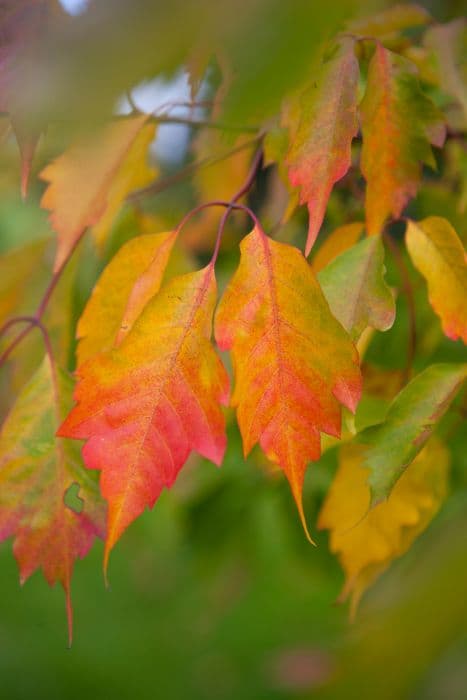Snakebark Maple Acer davidii Viper = 'Mindavi'

ABOUT
The Acer davidii Viper, commonly known as the Snakebark Maple, is a distinctive ornamental tree. One of its most striking features is the bark, which is a lovely shade of green interlaced with vertical white stripes, giving it a serpentine appearance that inspires its common name. This characteristic becomes more pronounced as the tree matures, providing winter interest when the leaves have fallen. The foliage of the Snakebark Maple is equally appealing. The leaves are arranged opposite one another along the branches, and each individual leaf showcases a classic maple shape with three to five lobes. During the spring and summer, the leaves display a bright green color. In the fall, the foliage transitions into a display of vivid colors ranging from yellow to orange and occasionally, a spectacular reddish hue. The Snakebark Maple also produces flowers and samaras (fruits). The small flowers are inconspicuous, typically in shades of yellow, and appear in drooping clusters in spring. Following the flowers, the tree develops samaras, which are winged fruits typical of maples. These fruits start green and mature to a tan or brown color, persisting on the tree into the winter and providing a visual interest as well as a food source for wildlife. Overall, the Snakebark Maple offers year-round beauty with its uniquely patterned bark, lush greenery, brilliant autumn colors, and interesting fruits. It can be a compelling addition to a variety of landscapes, valued for its ornamental features and seasonal transformations.
About this plant
 Names
NamesFamily
Sapindaceae.
Synonyms
David's Maple, Viper Maple, Snakebark Maple.
Common names
Acer davidii 'Mindavi'.
 Toxicity
ToxicityTo humans
The plant commonly known as Snakebark Maple is generally not toxic to humans. There are no significant reports of toxicity from ingesting parts of this plant. However, it is always advisable to avoid eating any plant parts unless they are known to be safe for consumption.
To pets
Similar to its effects on humans, the Snakebark Maple is generally not considered toxic to pets. There are no widely recognized symptoms of poisoning associated with this plant in animals. Nevertheless, it is always best to prevent pets from ingesting plants that are not intended for consumption to avoid any potential adverse reactions.
 Characteristics
CharacteristicsLife cycle
Perennials
Foliage type
Deciduous
Color of leaves
Green
Flower color
Varies
Height
20 feet (6 meters)
Spread
10 feet (3 meters)
Plant type
Tree
Hardiness zones
6
Native area
China
Benefits
 General Benefits
General Benefits- Ornamental Appeal: Acer davidii Viper (Snakebark Maple) has distinctive green and white striated bark and attractive foliage, providing year-round visual interest in the landscape.
- Seasonal Color: It offers a display of color with its autumn foliage which can turn shades of yellow, orange, and red.
- Wildlife Habitats: The tree produces seeds that serve as food for birds and other wildlife, supporting biodiversity.
- Shade Provider: As a moderate-sized tree, it can offer a pleasant shade during the hot seasons, making it suitable for parks and large gardens.
- Drought Tolerance: Once established, Snakebark Maple has some drought resistance, which can be beneficial in drier climates or during water restrictions.
- Adaptable Growth: It can adapt to a range of soil types as long as they are well-drained, providing flexibility in landscape design.
- Urban Tolerant: It exhibits a degree of tolerance to urban pollution, making it suitable for city environments.
- Low Maintenance: Requires relatively low maintenance compared to many other trees, with minimal pruning needs.
 Medical Properties
Medical PropertiesThis plant is not used for medical purposes.
 Air-purifying Qualities
Air-purifying QualitiesThis plant is not specifically known for air purifying qualities.
 Other Uses
Other Uses- Acer davidii Viper can be used in woodworking projects for its striking striped bark, which can add a unique visual element to furniture or decorative pieces.
- The wood from this tree is suitable for making musical instruments such as flutes or recorders due to its fine grain and workability.
- Branches from the Viper can be used in floral arrangements to add height and structure, especially during winter months when the contrasting bark stands out.
- Young saplings can be trained into living structures such as arbors or trellises in gardens, taking advantage of the tree's flexibility when young.
- The tree's striking appearance makes it an excellent candidate for photography projects, especially in autumn when leaves turn color or in winter when the bark is prominent.
- Leaves of the Viper can be used in crafts, such as leaf printing or leaf casting, for educational purposes or artistic exploration.
- Its distinctive bark can be used as a natural pattern in textile design, either through rubbings or photographic methods for unique fabric prints.
- Twigs and smaller branches may serve as natural stakes and supports for other plants in the garden, blending in more naturally than plastic or metal alternatives.
- The Viper's seeds can be used in seed art, a form of mosaic made from different seeds to create patterns or images, popular in some traditional crafts.
- In landscape design, the plant can be used to create a 'living screen' or privacy hedge due to its dense foliage and relatively fast growth.
Interesting Facts
 Feng Shui
Feng ShuiThe Davidii Viper is not used in Feng Shui practice.
 Zodiac Sign Compitability
Zodiac Sign CompitabilityThe Davidii Viper is not used in astrology practice.
 Plant Symbolism
Plant Symbolism- Adaptability: The Acer davidii Viper, commonly known as the Snakebark Maple, can adapt to a wide range of soils and climates, symbolizing the ability to thrive in various conditions.
- Strength: As a maple, it represents strength and endurance, due to its hardy nature and solid wood.
- Beauty: Known for its attractive bark and foliage, the Snakebark Maple epitomizes beauty and grace in the plant world.
- Uniqueness: Its distinctive green and white striated bark sets it apart from other maples, symbolizing the celebration of unique qualities and individualism.
- Growth: A tree that can reach substantial heights, it represents personal growth and the attainment of higher knowledge.
 Water
WaterThe snakebark maple prefers consistent moisture and should be watered deeply once a week during the growing season, but the frequency should be adjusted based on weather conditions—more often during dry spells and less during rainy periods. In general, aim to provide around 1-2 gallons of water per week for young trees, ensuring it penetrates the soil deeply to encourage root growth. During winter, you can reduce watering as the tree will be dormant and won't require as much moisture.
 Light
LightFor optimal growth, the snakebark maple should be planted in a location where it can receive full sun to partial shade. It thrives best with morning sunlight and some afternoon shade, especially in areas with hot summers, to prevent leaf scorch.
 Temperature
TemperatureThe snakebark maple is hardy and can tolerate a range of temperatures. It can survive in minimum temperatures down to around -20°F and is comfortable in maximum temperatures up to about 80°F. The ideal temperature range for this tree is between 60°F and 75°F, which promotes healthy growth.
 Pruning
PruningPrune the snakebark maple to remove any dead or damaged branches and to shape the tree as needed. This is best done during late winter or early spring before new growth starts. Pruning every 2-3 years can help maintain the tree's health and appearance, preventing overcrowding of branches and ensuring adequate light and air circulation.
 Cleaning
CleaningAs needed
 Soil
SoilSnakebark Maple thrives in well-draining soil rich with organic matter. The ideal soil pH for this plant is slightly acidic to neutral, ranging from 6.0 to 7.5. A mixture of loam, peat, and sand in equal parts is often recommended for optimal growth. Regularly adding leaf mold or compost will enhance soil fertility and structure.
 Repotting
RepottingSnakebark Maple generally does not need frequent repotting and can thrive in the same pot for several years. As a slow-growing tree, it may only need repotting every 3 to 5 years, but it's always best to check the root system annually for signs of being pot-bound.
 Humidity & Misting
Humidity & MistingSnakebark Maple prefers moderate humidity levels. Consistent humidity around 50-60% is beneficial but it is quite adaptable and can tolerate a range of humidity conditions as long as other needs such as watering and light are appropriately met.
 Suitable locations
Suitable locationsIndoor
Provide bright, indirect light and consistent moisture.
Outdoor
Position in dappled shade, protect from harsh winds.
Hardiness zone
5-7 USDA
 Life cycle
Life cycleAcer davidii 'Viper', commonly known as Snakebark Maple, begins its life cycle as a seed that germinates in spring after stratification through the cold winter. The seedling emerges and grows into a young sapling, which features the characteristic green and white striped bark. As the tree matures, it develops a more robust root system and sturdy branches, and reaches its full size within 20 to 50 years, commonly achieving heights of 10 to 20 feet. During the growing season, Snakebark Maple exhibits a dense canopy of green leaves that turn to vibrant shades of yellow, orange, and red in the fall. The tree produces small purple flowers which give way to winged samaras, and after pollination and seed set, the cycle begins anew with the dispersal of seeds. This deciduous tree ultimately enters a period of senescence where growth slows and it may succumb to environmental stresses, pests, or diseases, concluding its life cycle.
 Propogation
PropogationPropogation time
Spring-Early Summer
Propogation: The most popular method of propagating the Snakebark Maple, including the Acer davidii Viper or 'Mindavi', is through softwood cuttings. This technique involves taking a cutting of new, soft growth from the plant in late spring or early summer. Cuttings should be 4 to 6 inches long and have several leaves. After removing the lower leaves, the cut end of the cutting is dipped into rooting hormone to encourage root development. The cutting is then inserted into a well-draining soil mix, ensuring at least two nodes are buried where leaves were removed. The soil should be kept moist, but not waterlogged, and the cutting should be placed in an area with indirect sunlight. With consistent care and optimal conditions, the cutting should root within a few weeks, ready to be transplanted the following spring.









